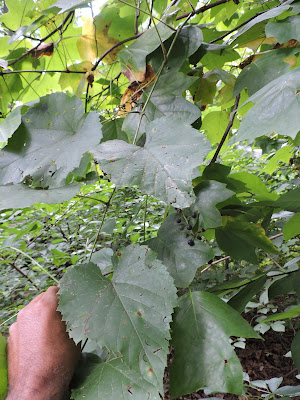 |
| The beautiful color many Red Maples have in the Fall. |
Red Maple (Acer rubrum) is considered by many to be the most common and widespread tree in the East. Although it prefers moist environments (it is sometimes called Swamp or Water Maple), it can tolerate and even flourish in many more habitats. It can tolerate the widest soil conditions of any North American native tree. It is resistant to even droughts once established and is not a favorite of deer. Because of this adaptability (along with some other qualities I'll mention later), it is one of the most frequently planted landscape trees. Perhaps it is overly planted in some cases. We often see it so heavily dominating planting plans that we recommend they find alternatives. Just about the only thing it doesn't tolerate is burning, and since we've suppressed forest fires, it often out competes other native trees such as oaks and hickories.
 |
| Red Maple leaves and samaras. |
Red Maples are medium sized trees, rarely growing taller than 90'. Like all maples, they're opposite leaved and their paired winged seeds are called samaras. They're the "helicopters" many kids play with and watch twirl down when thrown up in the air. The seeds start to germinate upon making contact with the ground.
 |
| Even the buds of Red Maple can be red in color. |
Red Maples are aptly named. Anthocyanins present in many parts of the tree impart this coloration in the Fall, particularly in acidic soils. The flowers, though small, also stand out in early spring, often in March, blooming before the tree leafs out. They provide much needed color over a still bleak landscape. The flowers are both wind and insect pollinated. Red Maples are not long lived trees, most don't get much older than 150 years, but they can start flowering by the time they're 5.
 |
| Red, sometimes called Scarlet Maple, flowers in bloom. |
Man has been making use of Red Maples for quite a long time. According to noted ethnobotanist Daniel Moerman, numerous indigenous tribes found uses for them. The Cherokee made an infusion from the bark to treat cramps, measles, diarrhea, hives, and what Moerman recorded as "female troubles." They were also among several tribes who also made an eye wash from the inner bark: the Ojibwa, Iroquois, and Potawatami for instance. The Iroquois also thought red maple could be a blood purifier and the dried bark used to make bread. Along with the Potawatami, they also used it to wash and deodorize their traps. The Seminole thought red maple could treat hemorrhoids, sore limbs, backs, muscles, and other of what they called "ball game sicknesses." The Abnaki used the sap as a sugary sweetener.
Francis Porcher, a Confederate doctor charged with developing uses of native plants as substitutes for goods no longer available due to wartime Union blockades, also mentions it's uses to make sugar. He thought it quite inferior though to Sugar Maple. He also noted the use of the bark to treat eye issues.
Maples have been used to obtain sweet syrup well before Europeans arrived into North America. Although all maples can supply sap that can be converted, none are as concentrated as are the Sugar Maples. Red Maples are not only lower in sugar concentrate, but they also have a shorter time they can be tapped. By the time buds start to open, the flavor becomes affected and no longer productive. The wood is a bit brittle, so sometimes the tree is referred to as Soft Maple in the commercial timber industry. But it is still used in furniture and other goods. Male cultivars tend to be more colorful, but also often are considered as producing highly allergenic pollen. Female trees on some cultivars may be less colorful, but also are considered to be much less likely to cause allergies.
 |
| Cut red maple twigs with buds are often a sign of squirrels feeding. |
But it's wildlife who may benefit the most this commonly planted tree. 297 different caterpillar species have been documented feeding on maples, which feed birds and bats. Many bird species eat the samaras, though they are not a preferred food as they become available during the early summer when birds feed more heavily on insects. Though toxic to horses, many mammals feed on maple. Deer don't prefer the foliage however, meaning it has a competitive advantage being allowed to grow in place of other plants deer consume.
As you can see, there are many reasons to plant this tree. No wonder it is the state tree of Rhode Island.







